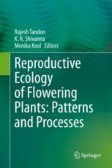Search
Search Results
-
Designing Tobacco Genomes for Resistance to Biotic Stresses
Tobacco is one of the important commercial crops in the world and is cultivated in more than 120 countries. Various biotic stresses viz. pests,...
-
Leveraging air-borne VOC-mediated plant defense priming to optimize Integrated Pest Management
Plant defense priming involves the release of air-borne volatile organic compounds (VOCs) by plants, serving to prepare defense-related mechanisms...

-
Small Papillae Regulated by
SPD25 are Critical for Balancing Photosynthetic CO2 Assimilation and Water Loss in RiceBackgroundThe leaf epidermis plays an important role in the transmission of light and the regulation of water and gas exchange, which influences the...

-
The circadian clock ticks in plant stress responses
The circadian clock, a time-kee** mechanism, drives nearly 24-h self-sustaining rhythms at the physiological, cellular, and molecular levels,...

-
Beyond 'push–pull': unraveling the ecological pleiotropy of plant volatile organic compounds for sustainable crop pest management
Plants produce an array of different volatile organic compounds (VOCs) that have diverse eco-physiological functions and agricultural applications....

-
Arbuscular Mycorrhizal Fungi: Potential Plant Protective Agent Against Herbivorous Insect and Its Importance in Sustainable Agriculture
Wide use of fertilizers and chemicals for food grain production to feed the world population with increasing demand leads to environmental pollution....
-
Simplified Perspective of Complex Insect–Plant Interactions
Scientific literature pertaining to the investigations on insect–plant interactions spans more than a century. This is a challenging frontier area...
-
Wheat PP2C-a10 regulates seed germination and drought tolerance in transgenic Arabidopsis
Key messageA wheat protein phosphatase PP2C-a10, which interacted with TaDOG1L1 and TaDOG1L4, promoted seed germination and decreased drought...

-
Induced Resistance and Defense Primings
Priming is a phenomenon in which plants upon treatment with a resistance-inducing agent acquire an enhanced defensive capacity to respond faster...
-
Biotic Influences: Ecological Biochemistry: Allelopathy and Defense Against Herbivores
Plants contain a vast array of compounds referred to as secondary metabolites that play no role in primary catabolic or biosynthetic pathways. Many...
-
Olfactory Cues as Functional Traits in Plant Reproduction
Floral scents are important traits which mediate interactions within biotic communities. These volatiles perform diverse functions, ranging from...
-
Eudicots (Part II)
Primarily north temperate but also subtropical and in West Indies and South Africa.
-
Agriculturally Important Fungi for Crop Protection
To feed the increasing population of the world farmers and the crop growers rely on the use of synthetic chemicals as pesticide and fertilizer for...
-
Biotic Stress
This chapter explores the reasons why plants rarely succumb to pathogens or herbivores. Even though plants are constantly under attack from viruses,...
-
Interactions Between Plants, Plant Communities and the Abiotic and Biotic Environment
In this chapter, the interactions between plants, plant communities and the abiotic and biotic environment are described. First, we discuss how...
-
Oral Secretions Affect HIPVs Induced by Generalist (Mythimna loreyi) and Specialist (Parnara guttata) Herbivores in Rice
Plants synthesize variable mixtures of herbivore-induced plant volatiles (HIPVs) as part of their evolutionary conserved defense. To elucidate the...

-
Belowground Experimental Approaches for Exploring Aboveground–Belowground Patterns
Experiments in aboveground–belowground community ecology are challenging, usually because manipulation and observation of the belowground component...
-
Engineering Plants for the Future: Farming with Value-Added Harvest
Plants and their rich variety of natural compounds are used to maintain and to improve health since the earliest stages of civilization. Despite...
-
Characterization of Citrus WRKY transcription factors and their responses to phytohormones and abiotic stresses
WRKY transcription factors (TF) family is involved in a huge variety of plant processes, including seed germination, plant development, phytohormone...
-
Polyamines in the Context of Metabolic Networks
Polyamines (PAs) are essential biomolecules that are known to be involved in the regulation of many plant developmental and growth processes as well...
